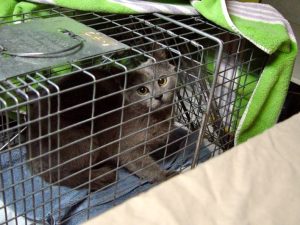1. “Hey, I saw a mom cat and kittens outside. What should I do?”

The answer is different depending whether the cats are tame or feral (wild). Either way, although your attention may be on the kittens (which is understandable because they’re so darn cute), any plan moving forward needs to focus, first and foremost, on the mom cat: and getting her sterilized (neutered) immediately, so she can’t have any more litters. Please read the FAQs further down about TNR-Trap, Neuter, Return If mom and kittens are tame (by “tame”, we mean they aren’t afraid to be picked up and handled) it’s much easier to get them to a vet and get everyone neutered, vaccinated, tested and ready for adoption. It’s also easier to find them stable, loving homes (please see our adoption primer for more info).
If mom and the kittens can’t be approached or touched they are probably feral (wild). You’ll want to read entry #24 in our “Urban Cat League Taming Ferals” blog which outlines the best strategy for trapping a feral mom and kittens for spay/neuter. You’ll want to read entry #26 to understand how important it is to start taming the kittens before they hit 8 weeks of age.
* And we have an entire section of this website devoted to taming feral cats and kittens, and preparing them for adoption. You will vastly increase your chances for success by reading this section first, BEFORE you take ANY cats or kittens off the street. With a careful, well-thought-out plan you can help these little guys find a better life off the street without getting scratched or bitten yourself in the process.
2. “How can I tame wild kittens and help them get adopted?”
Our kitten and feral cat taming page is full of everything you could ever want to know (and more) about taming ferals. We have a video demo of taming techniques, a printer-friendly print out of tips and a blog filled with ideas gleaned over years of hands-on experience taming feral cats and kittens. With these insights, and some perseverance on your part, chances are you can tame them and get them adopted. Check it out!
3. “What exactly is a Feral Cat?”

Cat lovers often disagree about what makes a cat “feral.” But, in its simplest terms, a feral cat distrusts humans and prefers not to associate with us, and are not candidates for “quick and easy” rescues or adoptions.
Trust of humans is a learned behavior for cats, not a genetic trait. Unlike other domesticated animals, cats are independently resourceful. They can often find a food source and easily survive without us especially in a rural setting (pigs can too, but that’s a whole other website).
In a big city, life is much more difficult. But, amazingly, cats can instinctively become hunters and/or scavengers almost instantly. In fact, Ferals are so good at finding shelter, and hiding from the elements, that most New Yorkers have never actually seen a feral street cat even though thousands live in our midst. HINT: Midnight-to-dawn is the best time to catch a glimpse. But, be warned: if they see you, chances are they won’t let you see them.
4. “Are all street cats ‘Feral’?”
Nope.
Many are lost or abandoned house cats, that, if brought in from the street, will instantly readjust to the comforts of home and hearth. But if these domestic cats reproduce on the street, their offspring can become feral in one generation (especially if the only human they see is an angry store owner chasing their mother away when she rummages through the garbage). On the other hand, if the mother cat continues to trust humans, and there is a friendly caretaker coming by daily to provide food, which the mother greets and is relaxed around, the kittens will probably be easy to tame and will trust humans too.
5. “Can all feral kittens be tamed?”

Under 8 weeks even the wildest kittens can usually be tamed or “socialized” to humans. Anything past 8 weeks takes a special brand of patience and commitment, but it can be done. Check out our taming blog, taming video and tips on taming feral cats and kittens to see how Urban Cat League socializes feral cats and kittens for adoption.
6. “What is involved in Trap-Neuter-Return (TNR)?”
TNR is a non-lethal sterilization method designed to reduce the numbers of feral cats, and end “nuisance behaviors” like mating season yowling, and the smelly spraying of territory.
TNR is a comprehensive, ongoing program, practiced by animal care organizations all over the world, in which stray and feral cats are humanely trapped, sterilized, vaccinated, ear-tipped (see below) and returned to their habitat as a way to halt the cycle of reproduction, and eliminate the nuisance behaviors associated with mating.
TNR Programs differ, but at Urban Cat League we also evaluate each cat to determine the best plan to suit each individual cat: Healthy adult cats too wild (feral) to be adopted are returned to their familiar habitat under the lifelong care of volunteers.
Kittens and tame (stray) cats are vetted and carefully adopted. Cats that are ill or injured are not returned to the colony until completely well. “At risk” cats are relocated to safer locations.
TNR is a hands-on project requiring commitment from one or more volunteer caretakers, often with help from feral cat advocates living in the area. TNR isn’t hard. But it is a responsibility. All it takes is a little bit of education, a little bit of free time, and a whole lot of love.
In communities where TNR is widely embraced, feral cat numbers have dropped significantly because it breaks the cycle of reproduction. TNR programs operate largely or entirely through the dedicated efforts of committed volunteers. TNR’d feral cat colonies can live long healthy lives, and, once educated, the public overwhelmingly supports TNR as the long-term “humane solution” to feral cat overpopulation.
7. “Where can I learn more about TNR?”

The The Community Cat Podcast holds frequent information and training workshops covering all aspects of organizing a TNR project. Consult their website and RSVP for the next workshop to learn about all of the free services for feral cats available in NYC.
If you live elsewhere, the websites of Alleycat Allies and Neighborhood Cats have lots of info about TNR for persons not able to attend a workshop in person. Those needing help to find a nearby feral cat TNR spay/neuter program can search by state at this ASPCA link.
TIP: Do a google search with the name of your town or state and the words “Feral Cat”, “TNR”, “low-cost Spay/Neuter” or similar words to find the groups nearest you promoting feral cat care.
8. “I am already alone caring for a group of cats. Can I do a TNR project alone?”
We recommend finding help. There are probably other caretakers like yourself that would welcome help to get a TNR project started in their area, too. And working together will make things much, much easier. Call your local Animal Control and local veterinary clinics and ask about other animal rescue groups, or individuals, that may already be doing TNR in your area.
Alleycat Allies will help you make these connections.
If they’re not a group already in-place, don’t worry. Somebody’s gotta get the ball rolling, right?. Every group that is currently doing TNR started as the idea of one person. But hopefully you won’t have to go it alone for too long. Try not to get overwhelmed. Set a realistic goal, and try to move forward to help the cats experience a better life.
9. “What is ear-tipping?”

You might have seen a cat or two with a square ear? Well, ear-tipping is a technique of painlessly removing the point off the top of a feral cat’s left ear while the cat is anesthetized for spay/neutering. Ear-tipping is the universal symbol to identify feral cats that have been neutered, vaccinated and are receiving daily care (TNR’d). Ear-tipping ensures that a sterile cat will not undergo unnecessary repeat surgery, and it also helps volunteers to spot any new unneutered cat that arrives in a “managed” colony of feral cats. For info to provide your veterinarian about the proper technique for eartipping a feral cat at the time of spat/neuter, go to alleycat.org Alley Cat Allies − Veterinary Care Guide −
10. “Is it cruel to leave cats outside?”

The safest place for tame, domesticated companion cats may be indoors, but the best −and often the only− option for feral (wild) cats is outside. Feral cats who have undergone TNR, and live in managed colonies, can live long, healthy and contented lives. Although all feral cats could (theoretically) transition to living happily indoors, finding homes for the thousands of feral cats in the world is not a realistic option. Humane societies, animal shelters, and other animal organizations require that cats “tolerate being touched and held” to be deemed “adoptable.” Because of that, most city shelters routinely kill feral cats unless local volunteer groups are actively practicing TNR to help reduce the feral population.


